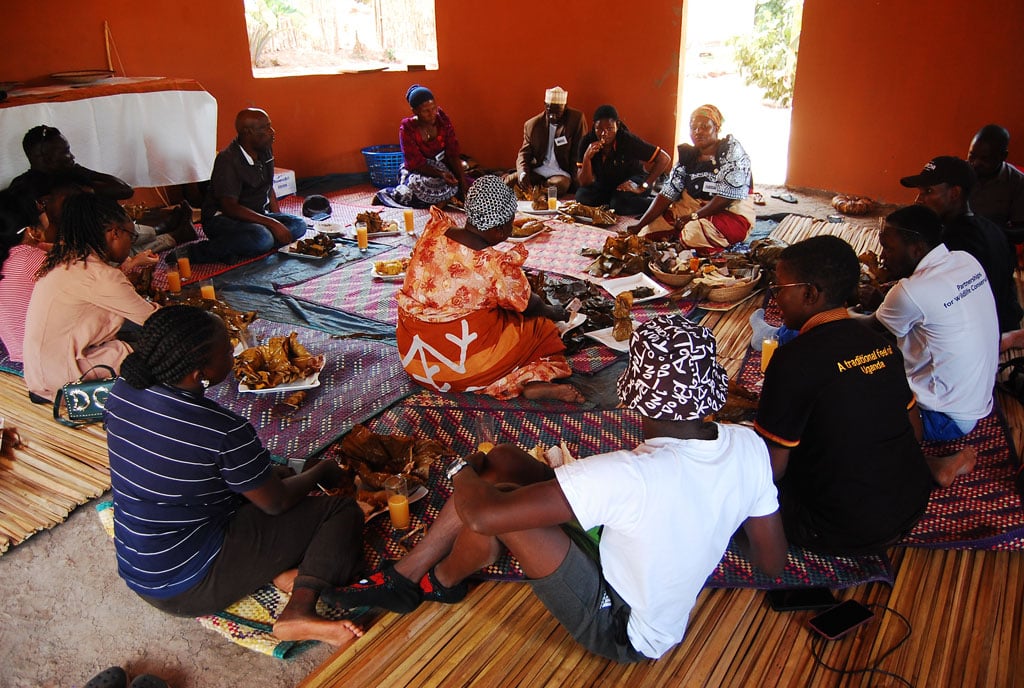Prime
Could culture be a viable addition to Uganda’s tourism menu?

Some of the guests at the Ewaffe Cultural Village in Naggalama. PHOTO/TONY MUSHOBOROZI
What you need to know:
- Explore Uganda.Forget the wildlife tourism that Ugandans market, have you noticed that cultural adventure is the new kid on most itineraries for tourists?
Humans are spellbound by the idea of ‘otherness’. You live all your life with a raging fascination with other people’s ways of life.
For instance, closer to home, the bravery and raw ruggedness of the Karimojong brings a twinkle to your eye. The agreeableness of the Lugbara enchants you. The audacious way of speech of the Bakiga is intriguing and not in the least intimidating. The good-naturedness and welcoming culture of the Baganda cultivates your love for humanity.
This may explain why community and cultural tourism exists. People want to spend money just to be in the presence of people who live differently from them.
Growing trend?
Cultural tourism has been growing in Uganda over the last decade or so. Many tour companies have cultural experiences on their offerings on top of the more popular wildlife expeditions.
The Batwa cultural experience is now a permanent fixture on most tours to Bwindi Impenetrable Forest in addition to gorilla trekking. A stopover at Igongo Cultural Museum in Mbarara is now almost always guaranteed for people travelling to the southwest for leisure.
Nshenyi Cultural Village in Ntungamo is popular with tourists who want to learn about the culture of Ankole pastoralists, Ankole cattle and the region’s crop farming, while Kabale Arts Centre offers a window into the culture of Bakiga and Kigezi people in general. All these places have been established over the last two decades.
Ewaffe Cultural Village
Recently, one such tourist destination was opened in Naggalama, Kayunga Road in Mukono. Ewaffe Cultural Village is probably the first of its kind in Buganda where tourists can now go to mingle with the people of Buganda in their natural habitat and soak in the people’s rich culture.
Traditionally, the Kabaka’s Palace in Mengo and Kasubi Tombs have served as important repositories of Buganda Kingdom’s historical grandeur traditions. However, the new tourist facility seeks to offer more hands-on cultural experiences to tourists. Where the former focus more on the kingdom and political history of Buganda, the latter focuses on the way of life of the average Muganda.
The cultural village, which officially opened in July, is found in a green valley, in a clearing in the middle of banana plantations and fruit trees, a few metres off Kayunga Road in Naggalama Trading Centre.
The fact that the woman behind it, Aisha Nabwanika, happens to be in her 20s, may be testament that the young people have their own ideas of what the tourism sector could be. It could also mean that as modernity threatens to cut us off our roots, the young people are instinctively going conservative. But most importantly, it could just be that cultural tourism is growing.
The village offers tourists a unique window into the norms and traditions of the Baganda.
The day-long experience involves spending time with the residents of Naggalama as they farm, fish, fetch water from the well, cook, and generally live life.
Tourists are also taken through among others, traditional cooking courses, pottery, alcohol brewing, basket and mat making, fishing, Buganda herbal medicines, storytelling, food tourism, traditional sex education and gender roles.
In their first month of operation, the venue recorded more than 60 visitors.
About the investor
“I conceived the idea in 2018 after I noticed that despite the rich cultural diversity we have as Uganda, we are reaping little as a country from cultural tourism, and in Buganda particularly, which is very rich, we are not telling these stories. We are not showing people where we have come from and how rich our culture is,” Nabwanika says.
Nabwanika has some experience in the tourism sector. She has worked for the Uganda Tourism Association for the last six years and is privy to the inner workings of the tourism machine. She knew as soon as she started working in the industry that there was need for cultural tourist destinations. And, she would create such a facility as soon as she had the means.
“In 2019, I started mobilising resources to start clearing the ground and building the visitor centre. The pandemic slowed us down until 2022 when we advanced in the building of the premises. We officially started accepting visitors in July,” she says, adding: “In the one month we have been open, we have received more than 60 tourists and I hope the numbers will be larger as we already have international visitors lined up.”
The tourism enthusiast plans to start hosting schools and her team is developing a bouquet for children.
“The children will learn about fishing, farming, mulching, and so on. This is to enrich the product further to make it more exciting and fun,” she says.
The experience
The writer got an invitation to visit the tourist destination with fellow journalists and social media influencers a few weeks ago.

One of the hosts demonstrates how to prepare luwombo. PHOTO/TONY MUSHOBOROZI
We arrived around midday to a beautiful scene of women and girls ululating, singing and dancing to traditional music. The men were moving about looking regal in their traditional tunics, making sure all the arrangements were perfect. They were taking charge. Buganda is a patriarchy today as it has always been, and it showed. The traditional gender roles were one of the most noticeable aspects of Kiganda culture.
After the traditional Kiganda greetings that involved our female hosts kneeling and firm handshakes from the male hosts, they offered us coffee beans as a sign of friendship, and a drink of fresh banana juice for refreshment that washed down the beans. One minute, we were journalists joshing about in our van, taking selfies. The next, we were cultural tourists soaking in Kiganda culture firsthand.
After the refreshments, we were taken on a crush course about traditional medicine. The tour guide, a 20-year-old tourism student took us through the different herbs that have historically been used to cure illnesses in Buganda. We were showed how to prepare aloe vera to treat malaria.
“Get two or three leaves and boil them in a litre of water. Add some honey if possible and leave the mixture to cool. Drink a cup of this juice after every meal until you feel better,” she said.
He also explained that eating okra regularly boosts immunity and lowers blood pressure, and that chewing lemon grass can treat tooth aches and bad breath.
Turmeric, the tour guide told us, is a very good source of “man power”, almost as good as ginger. Tobacco was hailed as a great pain relief herb. The Baganda of olden days were able to use these herbs to live long enough to see their progeny and propagate future generations.
We were led to the well that has probably outlived 10 generations, where the locals still fetch water. But, the shrine next to the well was conspicuously left unmentioned. Probably because while witchcraft is central to the culture, talking about is almost taboo and can only be talked about among the closest of friends.
The outdoor activities were concluded with a fishing expedition at a nearby fish pond, where preparing the fishing rod, the line, the hook and the bait were discussed. We also learnt how to make one of Buganda’s foremost contributions to civilisation; bark cloth.
Indoor activities
Since traditional gender roles are religiously adhered to, women took over the home activities. We returned to a big hut at around 3.30pm. There, we were taken through the art of making baskets, mats, clay pots and banana juice.
Cooking Buganda’s forefront delicacy luwombo, was something to behold. Much of Kiganda culture rotates around the husband. For instance, we were told during the luwombo session that it is advisable for a wife to hide the gizzard from the rest of the chicken. When the husband finishes, luwombo he discovers the gizzard as a bonus. He is reassured of his wife’s love and respect. A wife who does not do this lacks training and might lose her man soon.
“Luwombo is usually just one serving and belongs to the man of the house. When you serve him, he can pick one piece and give it to you. It is important as the head of the house to be generous with his wife,” the female teacher explained.
Lunch
It would not be a real cultural tourism experience without the great Kiganda cuisine. The yams were the fluffiest, the chicken luwombo heavenly, the steamed green vegetables seemed to have been chosen strictly for their great looks and the sweet potatoes were crunchy. The whole hut smelt like heaven as the tourists took their positions on the mats, in a circle, to enjoy the meal.
A meal was the perfect end to the great cultural adventure.
Quick notes
The cultural village which officially opened in July, is found in a green valley, in a clearing in the middle of banana plantations and fruit trees, a few metres off Kayunga Road in Naggalama Trading Centre.
The fact that the woman behind it, Aisha Nabwanika, happens to be in her 20s may be testament that the young people have their own ideas of what the tourism sector could be. It could also mean that as modernity threatens to cut us off our roots, the young people are instinctively going conservative. But most importantly, it could just be that cultural tourism is growing.




